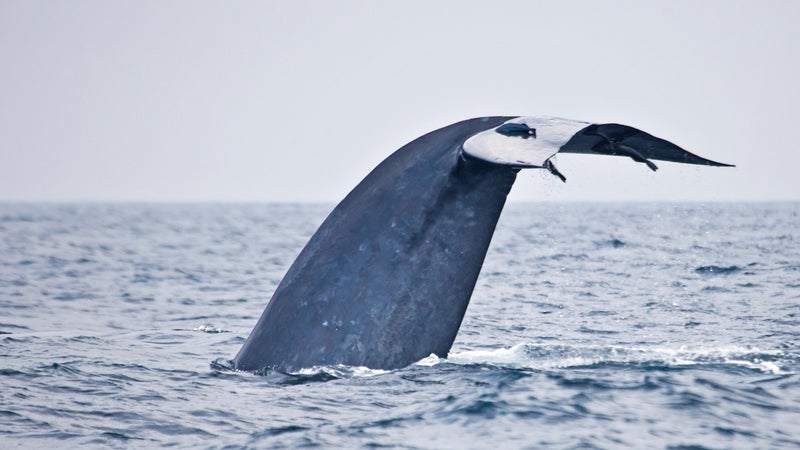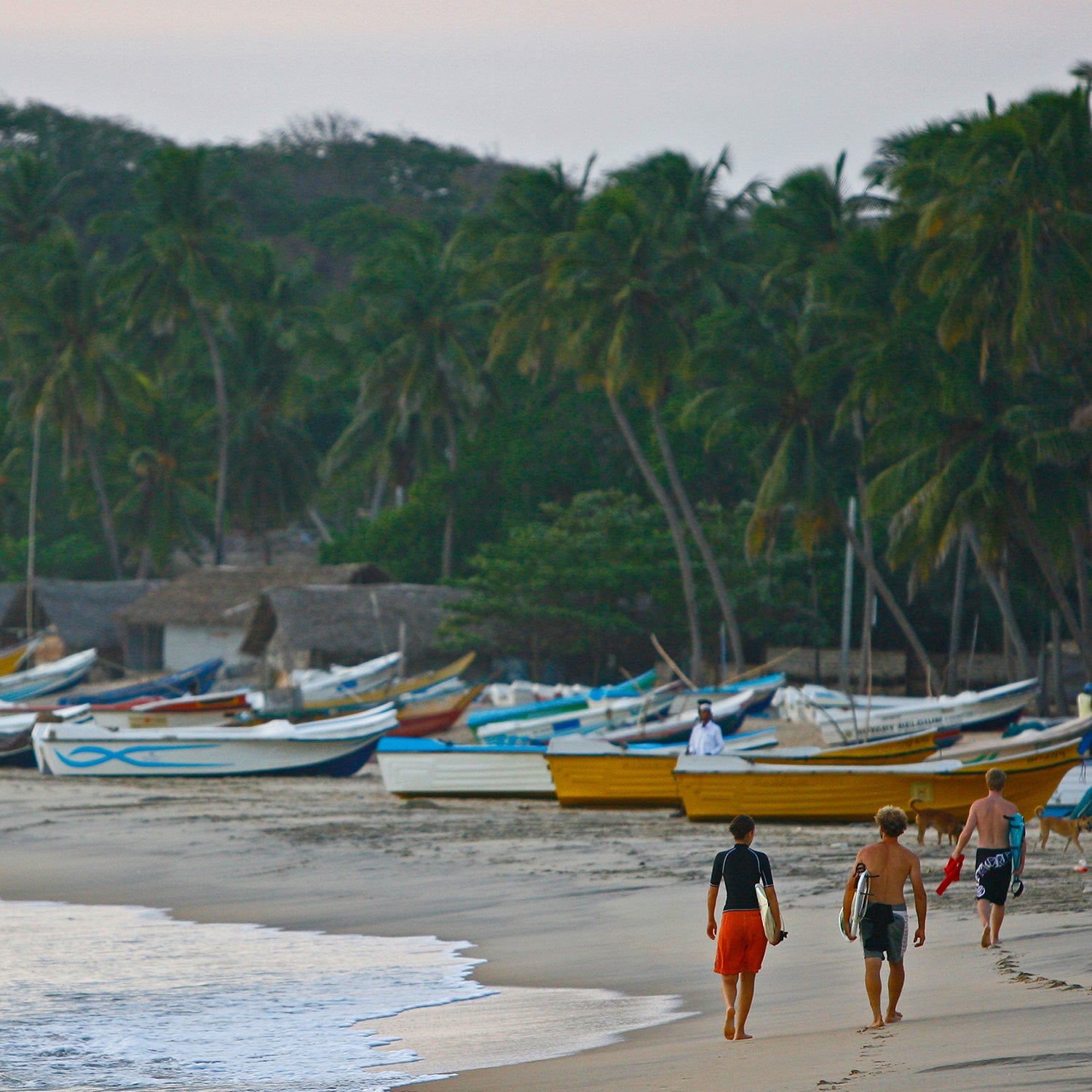At first, I couldn’t see anything to distinguish Weligama Bay. A mile-wide bite out of the Sri Lankan coast not far from the country’s southernmost tip, its arc of ochre sand and lilting palms appeared much the same as the miles of coastline I’d seen rushing past the windows on the three-hour train-ride from the capital Colombo.
Here and there, rows of bright-painted outrigger catamarans lay beached in the sun. Nearby, a huddle of dark-skinned fishermen sat in a half-circle repairing a shock of bright orange netting. The odd tourist ambled by, guests of the few low-slung lodges here that, until recently, marked the shores of Weligama Bay as one of the quieter stretches of Sri Lanka’s south coast.
All it took was a brief glance to the east to see how things are changing. Right at the bay’s apex the scenery was in the process of a dramatic transformation. Rising up over an acre of churned up earth, the 11-story exoskeleton of the Weligama Bay Marriott Resort & Spa, due to open in mid-2016, now dominated the skyline for miles.
A decade ago, it would have been fanciful to imagine a major international hotel chain taking a punt on this stretch of sand. But that was before May 2009, when government forces routed the LTTE, or Tamil Tigers, bringing a decisive end to the violent separatist insurgency that had blighted the island’s reputation for 26 years.
As news of the Tigers’ ultimate defeat spread, it was inevitable that tourists, formerly deterred by the intermittent bloodshed, would turn to the teardrop island like never before. Just two months after the defeat of LTTE, tourism arrivals had soared by 28 percent. Six years on, growth has averaged around 30 percent a year.
Rimmed in numberless beaches and surprisingly easy to get around, Sri Lanka squeezes a lot into an area barely larger than West Virginia. In the interior, the mountainous south offers alluring adventures for hikers. The northern flatlands, though less spectacular, are dotted with the ruins of ancient Buddhist monuments. Opportunities for wildlife-watching abound.
[quote]If realized, the $4 billion project’s sprawl of hotels, casinos and entertainment complexes would turn this sleepy backwater into a gaudy Gomorrah, out of keeping with its traditional culture.[/quote]
During my recent trip to Sri Lanka, the sense that the island has arrived at a critical juncture in the evolution of its travel industry formed an ever-present backdrop to the miles of tropical beaches, tranquil temples, and rippling tea-covered hills.
The government has been quick to throw the door wide open. Promotional campaigns have been launched in emerging markets like China and the eastern bloc. A deluge of foreign investment has seen the high-end, resort-style developments normally associated with west coast beaches like Bentota begin to spread outwards. Even the north, the war-scarred LTTE heartland around Jaffna, with its vivid Hindu heritage, is opening up to outsiders.
But all this growth comes with issues. With the government planning to , concerns are growing that the rush to cash-in risks fulfilling Paul Theroux’s cynical prophecy that “as soon as a place gets a reputation for being paradise it goes to hell.”
Nowhere is the conversation over development more pertinent than on the Kalpitiya Peninsula, a narrow isthmus snaking out of the country’s west coast. A peaceful haven, overlooked for most of the conflict, travellers have discovered the peninsula in recent years. In the south, sit unobtrusively alongside the fishing settlements on Alankuda Beach. In the north, , here to exploit year-round westerlies, have sprung up along the shore.
However, a brasher tourism is breaking-ground. An archipelago of 14 islands splintering off the peninsula’s northern tip—ranging from small sand-spits to 700 hectare Mutwal—has been designated a ‘Tourism Development Zone’. If realized, the $4 billion project’s sprawl of hotels, casinos and entertainment complexes would turn this sleepy backwater into a gaudy Gomorrah, out of keeping with its traditional culture.
“Local communities are apprehensive about the big projects,” warns Dilsiri Welikala, a young Colombo-born entrepreneur whose Robinson Crusoe style surf camp, , opened on the peninsula’s northwest edge in 2012. “We think small ventures that employ locally and respect the traditional fishing economy are much better for Kalpitiya than what the government has planned.”
As ever, there are environmental implications too. Once a target for LTTE terrorists, the famous Yala National Park, 378 square miles of monsoon forest in the island’s south-east corner, is seeing visitor numbers soar. Aided by the 2013 inauguration of the country’s second international airport at nearby Mattala, which receives daily flights from the Middle East, it’s a welcome shot-in-the-arm for the local economy. Meanwhile, the question of what the increasing jeep-traffic, and the accompanying noise pollution might mean for the park’s animals, the world’s highest concentration of leopards among them, has been relegated from view.
Mirissa, just down-coast from Weligama, is basking in its new-found reputation as one of the best places on earth to glimpse another superlative creature—blue whales. They feed in the abundant waters off Dondra Head, and are fast becoming one of Sri Lanka’s un-missable sights. Yet there have been widespread complaints that some of the less-experienced operators following in the wake of pioneers like risk distressing the whales by sailing too fast, and too close.

“When I drove into Mirissa last month it seemed that every ten meters there was an advertisement for whale-watching,” says , a leading Sri Lankan wildlife expert, who helped spread the word about the region’s blue whales in 2008. “Good practices are spreading, but it’s a struggle to keep up with a rapidly growing tourist industry.”
It’s hard to divine where tourism in Sri Lanka will be another decade from now. Only last week, , the country’s uncompromising leader for over a decade, was ousted from office in presidential elections. The development strategy of the new incumbent, Maithripala Sirisena, remains to be seen.
One thing is certain: as your whale-watching boat chugs back into the Mirissa dock, Weligama’s mile-wide beach hazy at the port-bow, the auguries looming ever larger on the horizon are not for everyone.
“The beginning of the end,” one cynical ex-pat says to me later at the dockyard, nodding in the direction of that Marriott’s silhouette towering in the west. Time will tell.
Get there: Flights to Colombo’s Bandaranayake Airport are available from several U.S. cities, including New York and Houston via stopovers in Europe and the Middle East. From the capital, an extensive bus and rail network provides relatively straightforward access to all corners of the .


